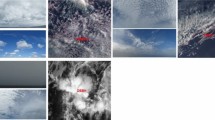Abstract
Tropospheric ozone, derived from the Scan-Angle Method (SAM) and the Convective Cloud Differential (CCD) method, exhibits a noticeable abundance over the South Atlantic, where it is associated with biomass-burning in the austral spring. This feature is also seen in the distribution of carbon monoxide observed from Measurements Of Pollution In The Troposphere (MOPITT). In the boreal burning season, however, the distribution of the results from SAM and MOPITT-CO present an enhancement related to the biomass-burning over North Africa that does not appear in the CCD results. The relationship of the results from SAM and MOPITT-CO is better than those of the results from the CCD and MOPITT-CO for the December-February period. Conversely, the latter relationship is better than the former for the October-November period. The two methods, SAM and CCD, show higher correlation in the southern burning season, but lower correlation in the northern burning season. The influence of biomass burning on ozone amounts is clearly seen in the SAM results of the elevated ozone over northern equatorial Africa during the northern burning season, but is not present in the CCD results.
Similar content being viewed by others
References
Fishman, J. and Larsen, J. C.: 1987, 'Distribution of total ozone and stratospheric ozone in the tropics: Implication for the distribution of tropospheric ozone', J. Geophys. Res. 92, 6627–6634.
Kim, J. H. and Newchurch, M. J.: 1996, 'Climatology and trends of tropospheric ozone over the eastern Pacific Ocean: The influences of biomass burning and tropospheric dynamics', Geophys. Res. Lett. 23, 3723–3726.
Kim, J. H., Newchurch M. J. and Han, K.: 2001, 'Distribution of tropical tropospheric ozone determined directly from TOMS measurements', J. Atmos. Sci. 58, 2699–2708.
Kirchhoff, V. W. J. H. and Rasmussen, R. A.: 1990, 'Time variation of CO and O3 concentrations in a region subject to biomass burning', J. Geophys. Res. 95, 7521–7532.
Newchruch, M. J., Sun D. and Kim, J. H.: 2001, 'Zonal wave-1 structure in TOMS tropical stratospheric ozone', Geophys. Res. Lett. 28, 3151–3154.
Thompson, A. M., Doddridge, B. G., Witte, J. C., Hudson, R. D., Luke, W. T., Johnson, J. E., Johnson, B. J., Oltmans, S. J. and Weller, R.: 2000, 'A tropical Atlantic paradox: Shipboard and satellite views of a tropospheric ozone maximum and wave-one in January-February 1999', Geophys. Res. Lett. 27, 3317–3320.
Ziemke, J. R., Chandra, S. and Bhartia, P. K.: 1998, 'Two new methods for deriving tropospheric column ozone from TOMS measurements: The assimilated UARSMLS/HALOE and convective cloud differential techniques', J. Geophys. Res. 103, 22,115–22,128.
Rights and permissions
About this article
Cite this article
Kim, J.H., Na, S., Newchurch, M.J. et al. Comparison of Scan-Angle Method and Convective Cloud Differential Method in Retrieving Tropospheric Ozone from TOMS. Environ Monit Assess 92, 25–33 (2004). https://doi.org/10.1023/B:EMAS.0000014506.58857.db
Issue Date:
DOI: https://doi.org/10.1023/B:EMAS.0000014506.58857.db




